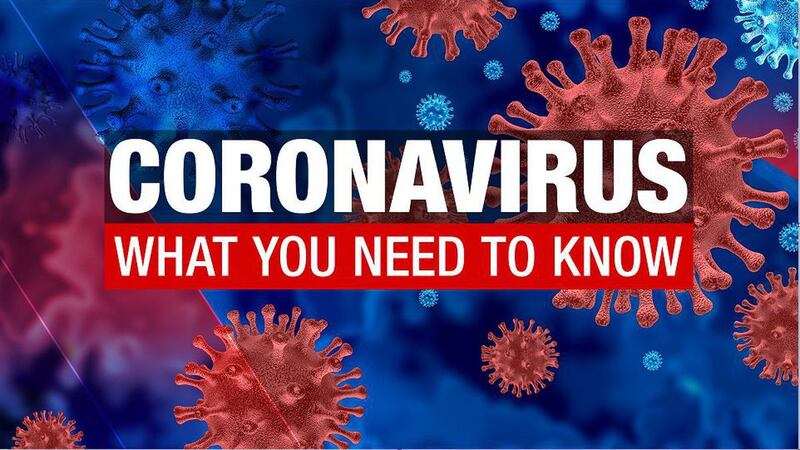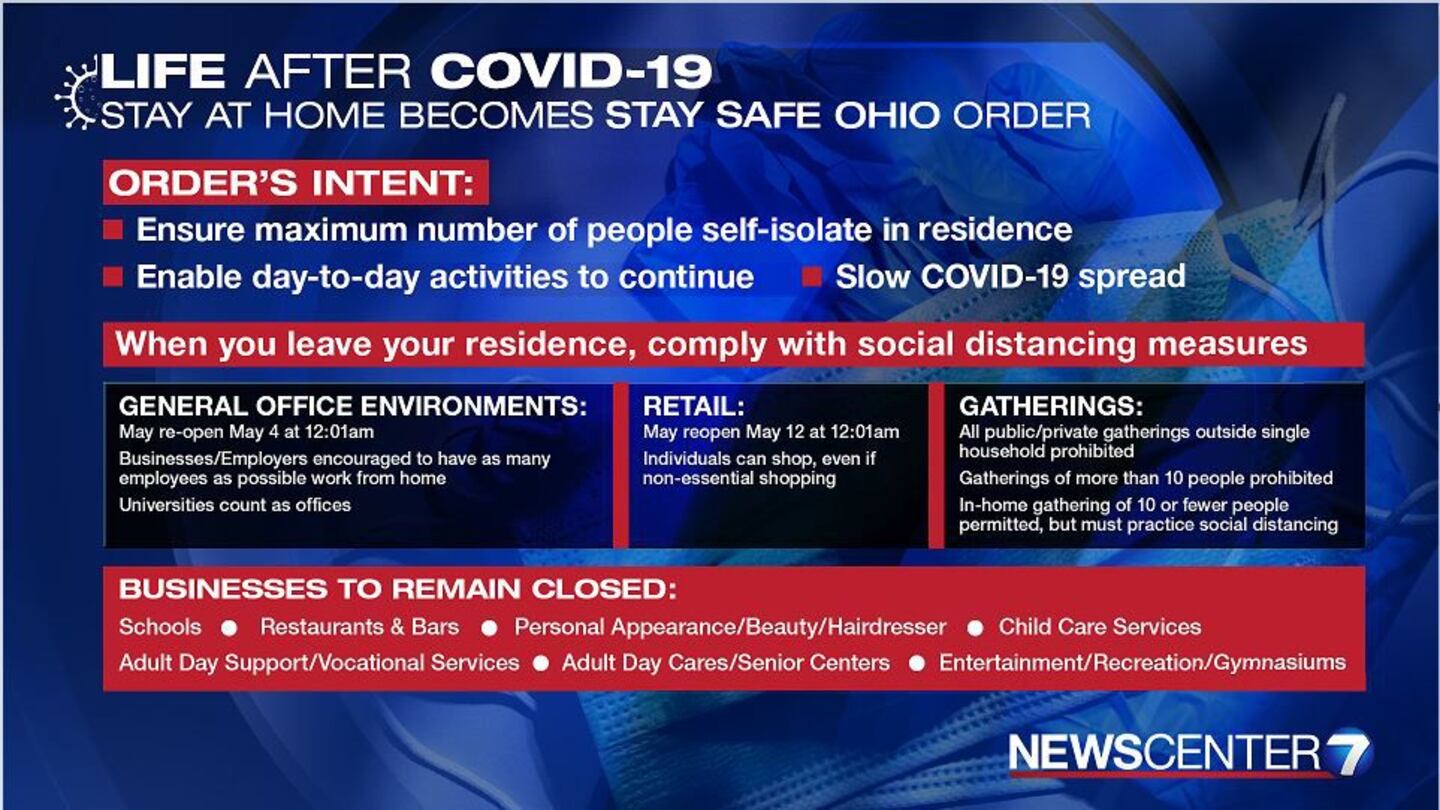Gov. Mike DeWine announced significant budget cuts of $775 million over the next two months in order to balance the state budget as required by law.
The proposed cuts took center stage during DeWine’s afternoon press conference.
The Stay-Safe-Ohio order will be superseded as new developments occur during the month, so the governor is warning everyone not to wed themselves to May 29, when the order is to expire.
He is expected to unveil plans to reopen restaurants and salons possibly on Thursday.
>> What does the new order look like?
The following announcements were made this afternoon:
- The state is below the state budget by $776.9 million. This is close to a billion-dollar change since February, when state revenues were ahead of budget by over $200 million.
- DeWine announced a $775 million budget reduction in General Revenue Fund spending for the remainder of the fiscal year 2020, which ends June 30. “If we don’t’ make these cuts now, the cuts we will have to make next year will be more dramatic,” he said.
- Of the money in the budget that is Ohio taxpayer-funded, only 9.4 percent is spent on operating expenses of state agencies. Over 85 percent goes out across the state as subsidies to schools, higher education, Medicaid services, local governments, etc.
- Instead of tapping into the rainy day fund over the next two months, the state has decided instead to make cuts. This will allow the rainy day fund to be used as the state enters the next fiscal year, which begins July 1, DeWine said.
- Cuts will be made in the following areas:
- Medicaid: $210 million
- K12 Foundation Payments: $300 million
- Other education budget line items: $55 million
- Higher education: $110 million
- All other agencies: $100 million
- The cuts to education mark a 3.7 percent overall budget reduction over the last year, DeWine said.
- DeWine said education and medicaid had to be targeted because of how much of the state budget those programs entail.
- State agencies will continue to operate under the travel freeze, with exceptions for those staff providing direct response to the emergency.
- DeWine has ordered a freeze on pay increases and promotions of unclassified and exempt staff, and a freeze on new contract series for the state.
- All state agencies are taking cuts, with the exception of the Department of Rehabilitation and Corrections. “I have asked each agency director to continue to identify savings in their budgets for the remainder of this fiscal year and next fiscal year,” DeWine said.
- DeWine said there are not plans for a Wednesday news briefing unless there is a significant development.
Public Health -- Dayton & Montgomery County held a briefing Tuesday afternoon on its continuing response to the virus.
Here are the highlights:
- EVICTION DEADLINES: The city of Dayton has extended the no-eviction policy until the end of May, Mayor Nan Whaley said, to give social service agencies time to get money to residents and more time for residents who are waiting for stimulus checks.
- WATER SHUTOFF DEADLINE: The city of Dayton also extended until the end of May the directive to not shut off residential water, Whaley said.
- CUSTOMERS & FACE COVERINGS: All businesses must meet all the protocols of Stay-Safe-Ohio as they reopen -- social distancing, limiting the number of customers, employees requiring employees to wear face coverings, etc. “It’s a new way of conducting business,” said Health Commissioner Jeff Cooper, Public Health -- Dayton & Montgomery County. “We’re asking you, even as a customer, though you are not required, to wear face coverings out of respect for other customers and employees,” Cooper said. PHDMC is encouraging employees who have concerns about the use of face coverings in the workplace to contact their human resources departments. Mayor Whaley also encouraged residents to wear face coverings in public, saying it’s “patriotic” to do so.
- ELECTIVE MEDICAL PROCEDURES: The process to resume elective medical procedures is moving slowly as area hospitals continue to monitor PPE stocks and hospitals prepare for the increase in testing, said Sara Hackenbracht, president/CEO, Greater Dayton Area Hospitals Association.
President Trump, at a Honeywell plant in Arizona, responded to questions from reporters about the federal government’s response to the virus.
Here is the highlight:
WHITE HOUSE COVID-19 TASK FORCE GOING AWAY?: Now that the nation has entered phase 2 of the White House plan to reopen, winding down the task force is close, President Trump said. He said certain people on the task force focused on certain things, such as the building of hospitals and ventilators. It’s a combination of safety and reopening now, he said, noting "we probably will have a different group set up for the safety and reopening. The mission will be accomplished “when this is over,” he said.
LATEST STATE DATA: As of Tuesday afternoon, there are 20,969 cases in the state, 1,135 deaths, and 3,956 hospitalizations, according to the Ohio Department of Health.
Ohio has an estimated population of approximately 11.7 million, census records show.
The state’s long-term care facilities have seen 15 percent of the total cases in Ohio.
Ohio Businesses Need Your Help
Of the state’s positive cases, 20% are from Ohio’s prisons. At those prisons, there has been an increase in testing.
[ Local cases, deaths reported to Ohio Department of Health ]
There have been 159,838 people tested for coronavirus in Ohio. In the state, 3,284 cases are health care workers, which is 16 percent of the cases.
It is important to note the number of confirmed cases is not a true reflection of actual cases in the state because of the limited amount of testing available. The hope is that the number of cases will be more accurate because of the expansion of the testing standards.
Things you need to know for today:
- The state has an advisory group for restaurants and another for barbershop/salons, working on crafting plans to reopen those businesses. The state also is putting together advisory groups for libraries, travel/tourism, sports, outdoor recreation, gym, theater, childcare, adult daycare facilities, and more.
- The FDA is allowing the emergency use of an experimental drug, remdesivir, which appears to help some coronavirus patients recover faster. It is the first drug shown to help fight COVID-19. The intravenous drug from Gilead Science would be for patients with “severe disease,” such as those experiencing breathing problems requiring supplemental oxygen or ventilators. Gilead CEO Daniel O’Day and Food and Drug Administration Commissioner Stephen Hahn were among those at the briefing. According to preliminary results from a government-sponsored study, the drug shortened the time to recovery about four days on average, the Associated Press reported. Dr. Anthony Fauci, National Institutes of Health, said this week the drug would become a new standard of care for severely ill COVID-19 patients. The drug has not been tested on people with a milder illness. Gilead will donate 1.5 million doses, O’Day said and is increasing production to make more
- DeWine said the state will plan to release the protocol and date that restaurants can reopen in the next few days. The groups planning these reopening protocols are involved in the restaurant industry and are almost finished with the plans.
- DeWine reminded Ohioans that beginning yesterday retail establishments can open by appointments and curbside pickup only. The remaining retail will reopen on May 12.
- The state has expanded its online graphs to show the trends of the various case data, now including graphs showing the last 21 day average. The trends, DeWine said, shows the state having a general decline in numbers.
- DeWine addressed the demonstrations that have happened outside the state house and outside Dr. Amy Acton’s home over the weekend. He said it is not fair game to target the family of Acton or the news media doing their jobs, when he is the person making the policy. “The buck stops with me. I’m the responsible person," DeWine said. “I’m the elected official who ran for office. I’m the one who makes policy decisions. Members of my cabinet work hard, but I set the policy.”
- DeWine touched on increasing testing capacity that is coming as May continues on. He reminded Ohioans that testing does not replace infection prevention and control.
- The state has unveiled new testing criteria:
- Priority 1: Ohioans with symptoms who are hospitalized or healthcare workers
- Priority 2: Ohioans with symptoms who are residents of longterm care, congregate living settings, first responders, public health workers, critical infrastructure workers, 65 or older or living with underlying health conditions. Ohioans without symptoms who are residents or staff directly exposed during an outbreak in longterm care or congregate living settings. Other Ohioans who are designated by public health officials to evaluate and manage community outbreaks.
- Priority 3: Ohioans with and without symptoms who receiving essential surgeries/procedures, including those that were reassessed after a delay, receiving other medically necessary procedures not requiring an overnight stay.
- The state has tested about 1.3 percent of the Ohio population for coronavirus.
- The opening of BMV locations in the state will not happen until later in May, Lt. Gov. Jon Husted said. The dates for individual locations will be announced at a later date. The state is also working to implement the “Get In Line Online" check in system at all locations to assist with crowds. This is a program that was already being rolled out prior to the pandemic.
How do we redefine work to create new value for customers and the business?
By Deloitte
Other things you need to know today:
- TESTING CRUCIAL: The NCAA’s top physician says testing if sports are to return this fall
- MAKING A DIFFERENCE: Area mom finances good deeds
- POCKETBOOK ISSUE: Can you write off work-at-home expenses?
- COVID-19 LIVE UPDATES: Read up on the latest news across the nation, world
© 2020 Cox Media Group







